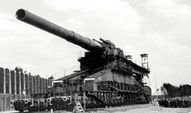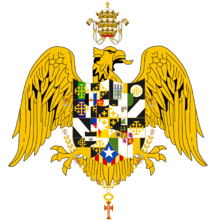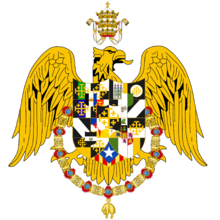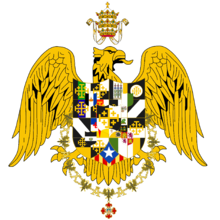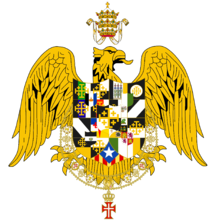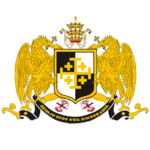Adolfo III of Creeperopolis
- In this Creeperian name, the first or paternal surname is Martínez de Ortega and the second or maternal family name is Schuessler de González.
| Adolfo III | |||||
|---|---|---|---|---|---|
 | |||||
| Reign | 14 June 1833 – 1 December 1887 | ||||
| Coronation | 15 September 1833 | ||||
| Predecessor | Manuel IV | ||||
| Successor | Maximiliano II | ||||
| 23rd Holy Protector of the State of the Church | |||||
| Reign | 14 June 1833 – 1 December 1887 | ||||
| Predecessor | Manuel IV | ||||
| Successor | Maximiliano II | ||||
| Supreme Pontiff | Gregorio XVI (1833–1846) Pío IX (1846–1878) Leo XIII (1878–1887) | ||||
| 1st Emperor of El Salvador | |||||
| Reign | 10 July 1858 – 1 December 1887 | ||||
| Predecessor | Monarchy established | ||||
| Successor | Maximiliano I | ||||
| Grand Prince | Maximiliano I | ||||
| 23rd King of Senvar | |||||
| Reign | 5 March 1839 – 1 December 1887 | ||||
| Predecessor | Wilhelm III | ||||
| Successor | Maximilian I | ||||
| 4th Emperor of the San Carlos Islands | |||||
| Reign | 14 June 1833 – 1 December 1887 | ||||
| Predecessor | Manuel II | ||||
| Successor | Maximiliano II | ||||
| 2nd Emperor of Lyoa | |||||
| Reign | 14 June 1833 – 19 August 1837 | ||||
| Predecessor | Manuel II | ||||
| Successor | Monarchy abolished | ||||
| Captain General | Crisóstomo Falcón Zavarce | ||||
| Born | 3 April 1803 Salvador, Salvador, Creeperopolis | ||||
| Died | 1 December 1887 (aged 84) San Salvador, San Salvador, Creeperopolis | ||||
| Burial | Cathedral of Christ the King 15 December 1887 Valley of the Fallen 15 September 1960 | ||||
| Consort | Isabela Hernández Guerrero (m. 1822; died 1875) | ||||
| Issue | |||||
| |||||
| House | House of Martínez–Pelayo | ||||
| Father | Salvador Martínez Ortega | ||||
| Mother | Mary Schuessler González | ||||
| Religion | Creeperian Catholicism | ||||
Adolfo III of Creeperopolis[note 1] (full name: Adolfo III Alexander de San Alfonso y San Miguel Martínez de Ortega y Schuessler de González; 3 April 1803 – 1 December 1887), also known as Adolfo the Great, was Emperor of Creeperopolis and the Creeperans and Holy Protector of the State of the Church from 1833 to 1887, Emperor of the San Carlos Islands from 1833 to 1887, Emperor of Lyoa from 1833 to 1837, and King of Senvar from 1839 to 1887. His reign oversaw Creeperopolis lose its overseas possessions of the Principality of the San Carlos Islands and the Second Lyoan Empire, but he also oversaw Creeperopolis' annexation of the Kingdom of Senvar, the annexation of the Castillianan department of Santa Ana, and the vassalization of the Kingdom of El Salvador into the Principality of El Salvador.
Adolfo III was born in Salvador, Salvador, Creeperopolis, the last Creeperian monarch to be born in Salvador and the last to be born outside of San Salvador, San Salvador. He was born to Salvador Martínez Ortega, the son of Salvador III, the pretender to the throne of Creeperopolis during the War of the Creeperian Succession, and Mary Schuessler González, the daughter of Senvarian King Wilhelm I.
He ascended to the throne of Creeperopolis on 14 June 1833 after the Revolution of 1833, deposing Emperor Manuel IV, who had effectively exiled Adolfo III's family to the Salvador Imperial Palace, in the process. The revolution was the second time in Creeperian history since 1231 that a military coup d'état transitioned power between two monarchs, with the first being the 1555 Creeperian coup d'état, and only being repeated a third time in the 2003 Creeperian coup d'état. He bestowed upon himself the title of Emperor of Creeperopolis and the Creeperans in 1834 and ruled Creeperopolis as a theocratically with the Creeperian Catholic Church's canon law, the Ten Commandments, and the Book of Leviticus as the highest laws in the country. Adolfo III's long reign of 54 years is commonly referred to as the Adolfisto, and during his reign, Creeperopolis faced several wars, including the Khalkovo War, the Lyoan Royal War, and the First and Second Senvarian Insurgencies. Adolfo III died in 1887, and his death ushered in the Second Parliamentary Era of Creeperopolis that would last until the outbreak of the Creeperian Civil War in 1933.
The legacy of Adolfo III in Creeperopolis has changed overtime. During his reign, many wars were waged and tens of thousands died as a result of those wars, ethnic minorities were attacked and persecuted, most notably the Deltinians, and he ruled as an absolute monarchy in a form of totalitarianism, but he also improved the country's economy and infrastructure, ended the totalitarian Manuelisto period, and improved the quality of life for the average Creeperian. During the Second Parliamentary Era, Adolfo III was seen as a tyrant and negative figure in Creeperian history, but during and after the Creeperian Civil War, he has been revered by the Creeperian Initiative as a great and important Creeperian ruler. He has been named as one of the Five Great Monarchs of Creeperopolis, with the other four being Kings Alfonso I and Miguel I and Emperors Manuel III and Romero I. During his own reign, Adolfo III styled himself as a new Alfonso I. His form of government has subsequently influenced the ideology of Romerism of the modern day Creeperian Initiative.
Contents
Early life
Adolfo Alexander Martínez Schuessler was born on 3 April 1803 in the Salvador Imperial Palace in Salvador, Salvador, Creeperopolis. He was the second child of Prince Salvador Martínez Ortega and Princess María Schuessler González. He had five siblings: Salvador (1802–1824), Félix (1805–1891), María (1807–1889), Miguel (1810–1845) and Antonio (1815–1867). His fraternal grandparents Emperor Salvador III, the Salvadorist claimant to the throne of Creeperopolis, and Empress-Consort María Ortega Hernández. His maternal grandparents were King Wilhelm I of the Kingdom of Senvar and Queen-Consort Wilhelmina Sonder. He was born as a member of the House of Martínez–Pelayo.
In his childhood, Adolfo lived within the Salvador Imperial Palace under the de facto house arrest of Manuel IV, his granduncle who defeated his grandfather during the War of the Creeperian Succession of 1783 to 1790. He, along with the rest of his immediate family, was rarely allowed to leave the Imperial Palace's grounds. The first time he left the Imperial Palace was on 6 July 1810 when he was present at a military parade in San Salvador, San Salvador which commemorated the Manuelist victory in the War of the Creeperian Succession.
Following his experience with the military parade in 1810, Adolfo began to take an interest in the military history of Creeperopolis and began to grow aspirations to become a military officer in the Imperial Army. He made a request to become an officer in the army in 1821 when he was 18 years old but he was denied. He requested again later in 1821, but was again rejected. He made a third request in 1822 directly to Manuel IV and he reluctantly allowed him to join the Imperial Army. Manuel IV was hesitant as he was the grandson of his former rival, but he was not the eldest grandson, as he still had suspicions that Martínez Ortega and his eldest son Salvador would conspire against him.
Adolfo enrolled in the Creeperian Academy of War in San Salvador where he was educated in military history, tactics, and skills. He began with the rank of Lieutenant Colonel, the lowest rank given to all royals preparing to become officers in the Imperial Army. He completed his education in 1826 and was promoted to the rank of Colonel.
Military campaigns

Adolfo was promoted to Major in 1829, but he wanted more. He was of royal descent, and he demanded that Manuel IV promote him to a higher rank. Manuel IV submitted and promoted Adolfo to Lieutenant General in 1830, the third highest rank, after General and Field Marshal.
As a Lieutenant General, Adolfo gathered a following of soldiers who supported him, and many wished to establish him on the throne, as Manuel IV was growing old and was becoming an unpopular Emperor. Soldiers in the army began to only take orders from Adolfo by 1833. Manuel IV had enough of what he believed to be a mutiny against his orders, and stripped Adolfo of his rank and kicked him out of the Imperial Army on 12 June 1833.
Rise to power
Revolution of 1833
Upon hearing of the firing of Adolfo, many Generals and Field Marshals grew a bad taste for Manuel IV and defected to the cause of Adolfo. Adolfo had begun to rally up supporters in Helam and began marching his troops to San Salvador on 13 June.
Manuel IV realized that the military is turning against him and orders for Adolfo's arrest, along with the arrest of any supporters. Manuel IV had Field Marshal Fidel Amaro Sánchez order the troops following Adolfo to arrest him, but the soldiers refused to listen. Amaro was then arrested by Adolfo's soldiers and executed via firing squad, marking the beginning of the Revolution of 1833.

Upon hearing the death of his most loyal Field Marshall, Manuel IV ordered the palace guards to arm themselves and defend the Imperial Palace of Creeperopolis to the death while he and his family hid within the palace preparing for the end, as the entire military has turned against him.
Adolfo recruited the help of Miguel Cabañeras Gutiérrez, a former Field Marshal who fought alongside Salvador III during the War of Succession, to depose Manuel IV from power. Adolfo promoted Miguel to Chief Field Marshal, signaling to the soldiers and officers that Adolfo is declaring himself as the true Emperor of Creeperopolis.
The soldiers arrived at the Imperial Palace at 12 noon and began to fire at the palace guards defending the palace. The well trained soldiers overwhelmed the outside defenders and infiltrated the palace. Cabañeras declared that no-quarter will be given to the palace guards, leading to very heavy guard fatalities.
The army had secured the palace by 3pm and had Manuel IV and his family captured and arrested.
At 3:30pm, Adolfo had Manuel IV and his heir, Grand Prince Manuel Martínez Figueroa, executed to prevent any claimant from Manuel IV's lineage arising to challenge his own power. The rest of his family was placed under house arrest and moved to the Salvador Imperial Palace, where Adolfo had been held prisoner throughout most of his childhood.
Adolfo declared himself Emperor of Creeperopolis and the Creeperans, Adolfo III, at 4pm, thus beginning his reign over Creeperopolis and establishing Salvador III's lineage on the Imperial throne of Creeperopolis.
Later that day, Adolfo III was given a letter from Pope Gregorio XVI himself congratulation him on his rise to power. He hopes that Adolfo III can revive and strengthen Creeperopolis's Creeperian Catholic heritage.
Reign
Adolfo III was officially coronated by Pope Gregorio XVI on 15 September 1833.
Adolfo III reversed many secularist policies imposed by Manuel IV during his reign, allowing the Creeperian Catholic Church to have enormous influence over the Empire. The Canon Catholic Law was imposed over the Empire as the highest law of the land in 1834 and the Ten Commandments were instituted as the highest of the highest laws. Creeperopolis was commonly labeled as a Theocracy because of these laws.
Economic policy
On 18 February 1834, Adolfo III authored a manifesto called the Creeperian Investment into Natural Resources Gifted by God. His manifesto called for Creeperian workers to help the government mine gold, iron, and silver in the griund of the nation to help industrialize the nation. He claimed that God himself ordered him to write his manifesto and that God wanted all Creeperans to mine these minerals. The mainfesto gained popular support quickly, and on 17 August 1834, Adolfo III established the National Mining and Smelting Corporation, a massive conglomerate composed of subsidiaries which focus on mining and smelting iron, gold, and silver. Abbreviated as CORNAMIF, the corporation was given a monopoly on the Creeperian mining industry.
First Senvarian Insurgency

Adolfo III also vastly expanded the military power of Creeperopolis during his reign. On 1 March 1839, Adolfo III gave an ultimatum to the neighboring Kingdom of Senvar to accept a peaceful annexation into Creeperopolis or face a devastating invasion. King Wilhelm III's military advisors begged him to refuse the ultimatum and go to war with Creeperopolis but he knew that his military was no match for Adolfo III's military might so he caved into the ultimatum.
Senvar was absorbed into Creeperopolis on 5 March 1839 and Adolfo III was declared King Adolfo I of Senvar. Wilhelm III was given compensation by free residence at the Palace of Puerto Sonsatepan and Adolfo III promised that he and his family will be cared for. He gave Wilhelm III power over the administration of Puerto Sonsatepan as a vassal to him.
Many Senvarians refused to accept Creeperian rule, however. Senvarian monarchists, loyalists, and nationalists, under the command of the King's brother, Frederick Schuessler I, fought the Creeperans refusing to accept annexation. The First Senvarian Insurgency, also called the First Senvarian Insurgency, was Adolfo III's first true military conflict against a determined enemy.
The Creeperian Army's superior numbers, experience, and organization proved to be its greatest strength against the Senvarians' lack of combat skill, smaller numbers, and lack of any sort of organization and unity. His troops' unity was exemplified during the Siege of Südhafen where his soldiers, despite outnumbered two to one, overpowered the Senvarians defending the city and its walls after four months of siege.
Adolfo III's army's greatest weakness was its lack of knowledge of the Senvarian landscape and terrain. The thick forests were perfect hideouts for insurgents to retreat to and rest only to prepare to attack the Creeperans over and over. The Senvarians mainly used guerrilla tactics which greatly reduced the efficiency of the Creeperian Army.
In the end however, the Creeperans triumphed when Frederick Schuessler I was killed in the Second Battle of Puerto Sonsatepan in 1857. Over the course of the year, the Senvarians surrendered and accepted Creeperian rule. In return, Adolfo III agreed to enforce the Creeperian Constitution's granted autonomy the departments of Senvar and Sonsatepan.
Inter-insurgency period
Following his military triumph over the Senvarians, Adolfo III looked to the northwest and set his sights on a conquest of the Kingdom of El Salvador.
The kingdom was surrounded on all sides by mountain ranges providing it protection from invasion. The kingdom itself lay in the Salvadoran Valley with its capital, Ciudad Los'Ángeles, lying on the Granada River.
Adolfo III pressured the kingdom to submit to his rule after offering them vassal status instead of annexation in 1858 establishing the Principality of El Salvador. The Grand Prince of Creeperopolis was now considered the Grand Prince of El Salvador.
Second Senvarian Insurgency
In 1878, Adolfo III suspended autonomy for Senvar and Sonsatepan and began treating the two departments just like any other Creeperian department. The decision was met by outrage from the Senvarians. Under Otto Schuessler I, the grandson of Frederick Schuessler I, the Senvarians rose up in a second guerrilla rebellion.
The insurgency was unpopular among the Creeperian populace and the people began protesting the war in 1881 demanding for it to end. Adolfo III ignored the people and continued the war.
The people began calls for the establishment of a second Parliament.
Marriage and private life
Both of Adolfo's parents wanted him married as quickly as possible so that their line of the family is guaranteed to not die out. His parents convinced Castillianan King José VII to marry off on of his daughters, Isabela Hernández Guerrero, to Adolfo. Adolfo married Isabela 28 December 1822 when both were only 19 years old.
Their marriage lasted 52 years, 42 of which were as Emperor and Empress-Consort. Isabela died on 15 March 1875 in San Salvador. Adolfo III held a large funeral for her, involving 3,000 soldiers, on 20 March 1875 and she was buried in the Cathedral of Christ the King. Adolfo III had several paintings or her commissioned in her memory following her death.
Death
Adolfo III died on 1 December 1887, from a stroke in the San Salvador Imperial Palace. He was succeeded by his son Maximiliano II. Maximiliano II accepted the peoples' cry and called for a cease fire to the war and arranged elections for a Second Parliament. The war would officially end on 3 October 1888, and Senvarian and Sonsatepanian autonomy was restored.
Legacy
During the Second Parliamentary Era of Creeperopolis (1887–1933), Adolfo III was portrayed as a cruel tyrant and was viewed negatively by 60% of the Creeperian population, with only 35% viewing him favorably.
However, during the Creeperian Civil War, the Romerists portrayed Adolfo III in a positive light as an Emperor of the people and an Emperor of freedom and Catholicism.
After the 2003 Creeperian coup d'état, the government of Alexander II, under orders of Augusto Cabañeras Gutiérrez, compared the coup of 2003 to the Revolution of 1833, a victory for Creeperopolis and a defeat for tyranny and oppression.
Adolfo III has been posthumously called "Adolfo the Great."
In propaganda
Commemoration
The Imperial Order of Adolfo the Great was created on 3 April 1952 by Emperor Romero II. It is awarded for "exceptional service to the Fatherland above and beyond the call of duty, or for putting one's life in exceptional risk for the Fatherland's well-being, or for exceptional contributions to the Fatherland in a combat or non-combatant manner." The Imperial Order comes in four grades: Grand Cross, Cross, Grand Knight, and Knight.
On 15 September 1960, Adolfo III was buried in the Valley of the Fallen, a large basilica and memorial to fallen soldiers of the Creeperian Civil War. Beginning in 1960, the Creeperian government began reburying its previous monarchs in the valley. A statue of Adolfo III was erected at his burial tomb.
3 April was declared Día de Adolfo (translated as Day of Adolfo) by the Creeperian government in 1987. Lyrics in the second verse of the Himno Real Creeperiano (translated as the Creeperian Royal Anthem) reference the Revolution of 1833: "Enemigos siempre atacaron, Creeperopólis siempre gano" (translated as "Enemies have always attacked [us], [but] Creeperopolis has always won"), with the "enemies" referring to the Manuelists of the War of the Creeperian Succession and "Creeperopolis" as a whole meaning Adolfo III and the people of the country, with the "always won" being the revolution itself.
In popular culture
Film
| Year | Film | Director(s) | Actor | Period covered |
|---|---|---|---|---|
| 1987 | Adolfo III | Carlos Muñoz Casanova | Federico Mena Quiñón | Entire life |
| 2002 | Los'Senvarianos | Manuel Figueroa Yagüe | Hugo Rosales Letín | First Senvarian Insurgency |
| 2005 | La'Atlácatl | Gustavo Obregón Tassis | Carlos Ureña Uribe | Disappearance of the BIC Atlácatl |
| 2013 | Adolfo III | Gustavo Obregón Tassis | Héctor Bonilla Bolaños | Entire life |
Television
Literature
- The 2013 book La'Revolución de 1833 by Orlando Pareja Palau covers and outlines the events of the Revolution of 1833.
- The 2015 book Adolfo III by Pareja Palau covers and outlines the events of Adolfo III's life.
Military
- Adolfo Pesado was a railroad gun built by the Catholic Imperial Restoration Council during the Creeperian Civil War. The gun was named after Adolfo III and the late Minister of Defense and Chief Field Marshal Adolfo Cabañeras Moreno.
- The BIC Emperador Adolfo III (BIC-68) is a Creeperian Naval aircraft carrier which has been in service with the Creeperian Navy since 1976.
- The 36th Creeperian Army is nicknamed the Ejército de Emperador Adolfo III (translated as Army of Emperor Adolfo III).
Music
- Several songs and corridos have been made in honor of Adolfo III.
Other
- Adolfo III Alexander Martínez Schuessler International Airport (AAM, CAAM, AAM) is the primary international airport of Adolfosburg.
- The Gold Star Line operates an ocean liner on their domestic route called the MV Emperador Adolfo III.
- The Torre Emperador Adolfo III in San Salvador is the tallest building in Sur standing at 1,096 pies (1,002 feet; 305 meters).
Issue
Adolfo III and Isabela had nine children.
| Name | Portrait | Lifespan | Notes |
|---|---|---|---|
| Adolfo Salvador Martínez Hernández |

|
31 October 1823 – 19 March 1855 (aged 31) |
Grand Prince 14 June 1833 – 19 March 1855; died in the First Senvarian Insurgency. |
| Isabela María Martínez Hernández |

|
1 March 1825 – 9 July 1888 (aged 63) |
|
| Gustavo Pelayo Martínez Hernández |

|
18 November 1827 – 19 January 1876 (aged 48) |
Grand Prince 19 March 1855 – 19 January 1876. |
| Angela María Martínez Hernández |

|
13 April 1829 – 22 September 1895 (aged 66) |
|
| Alexandra María Martínez Hernández |

|
28 May 1832 – 28 February 1905 (aged 72) |
|
| Maximiliano II Adolfo Martínez Hernández |

|
19 September 1834 – 18 October 1898 (aged 64) |
Grand Prince 19 January 1876 – 1 December 1887; succeeded Adolfo III to the crowns of Creeperopolis, the State of the Church, El Salvador, and Senvar. |
| María Isabela Martínez Hernández |

|
19 September 1834 – 6 June 1903 (aged 68) |
|
| Gloria María Martínez Hernández |

|
30 August 1836 – 9 December 1925 (aged 89) |
|
| Enrique Alfonso Martínez Hernández |

|
31 December 1838 – 17 April 1936 (aged 97) |
Titles, styles, honors, and arms
Gallery
Titles and styles
| Royal styles of Emperor Adolfo III | |
|---|---|
 | |
| Reference style | His Imperial Majesty |
| Spoken style | Your Imperial Majesty |
| Alternative style | Sir |
Adolfo III's full title as Emperor was:
"By the Grace of the Lord, our God, Adolfo III, Emperor of Creeperopolis and the Creeperans, Emperor of all Catholics, Imperial Commander-in-Chief of the Imperial Army of Creeperopolis, Imperial Commander-in-Chief of the Imperial Naval Forces of Creeperopolis, Imperial Commander-in-Chief of the Imperial Guard of Creeperopolis, Holy Protector of the State of the Church, Emperor of El Salvador, Emperor of the San Carlos Islands, Emperor of the Second Lyoan Empire, King of Senvar, Archduke of Abdan, Archduke of Adolfosburg, Archduke of Helam, Archduke of Jakiz, Archduke of La'Libertad, Archduke of La'Unión, Archduke of Salvador, Archduke of San Luís, Archduke of San Miguel, Archduke of San Pedro, Archduke of San Romero, Archduke of San Salvador, Archduke of San Salvador del Norte, Archduke of Santa Ana, Archduke of Senvar, Archduke of Sonsatepan, Archduke of Zapatista, Duke of Puerto Francisco."
| Title | From | To | Regnal name | |
|---|---|---|---|---|

|
Emperor of Creeperopolis and the Creeperans | 14 June 1833 | 1 December 1887 | Adolfo III |
| 54 years and 170 days | ||||

|
Holy Protector of the State of the Church | 14 June 1833 | 1 December 1887 | Adolfo II |
| 54 years and 170 days | ||||
| Emperor of El Salvador | 10 July 1858 | 1 December 1887 | Adolfo I | |
| 29 years and 144 days | ||||

|
Emperor of the San Carlos Islands | 14 June 1833 | 15 September 1834 | Adolfo I |
| 1 year and 93 days | ||||

|
Emperor of the Second Lyoan Empire | 14 June 1833 | 19 August 1837 | Adolfo I |
| 4 years and 66 days | ||||

|
King of Senvar | 5 March 1839 | 1 December 1887 | Adolfo I |
| 48 years and 271 days | ||||

|
Archduke of Abdan | 14 June 1833 | 1 December 1887 | Adolfo III |
| 54 years and 170 days | ||||

|
Archduke of Adolfosburg | 14 June 1833 | 1 December 1887 | Adolfo III |
| 54 years and 170 days | ||||

|
Archduke of Helam | 14 June 1833 | 1 December 1887 | Adolfo III |
| 54 years and 170 days | ||||

|
Archduke of Jakiz | 14 June 1833 | 1 December 1887 | Adolfo III |
| 54 years and 170 days | ||||

|
Archduke of La'Libertad | 14 June 1833 | 1 December 1887 | Adolfo III |
| 54 years and 170 days | ||||

|
Archduke of La'Unión | 14 June 1833 | 1 December 1887 | Adolfo III |
| 54 years and 170 days | ||||

|
Archduke of Salvador | 14 June 1833 | 1 December 1887 | Adolfo III |
| 54 years and 170 days | ||||

|
Archduke of San Luís | 14 June 1833 | 1 December 1887 | Adolfo III |
| 54 years and 170 days | ||||

|
Archduke of San Miguel | 14 June 1833 | 1 December 1887 | Adolfo III |
| 54 years and 170 days | ||||

|
Archduke of San Pedro | 14 June 1833 | 1 December 1887 | Adolfo III |
| 54 years and 170 days | ||||

|
Archduke of San Romero | 14 June 1833 | 1 December 1887 | Adolfo III |
| 54 years and 170 days | ||||

|
Archduke of San Salvador | 14 June 1833 | 1 December 1887 | Adolfo III |
| 54 years and 170 days | ||||

|
Archduke of San Salvador del Norte | 14 June 1833 | 1 December 1887 | Adolfo III |
| 54 years and 170 days | ||||

|
Archduke of Santa Ana | 14 February 1845 | 1 December 1887 | Adolfo I |
| 42 years and 290 days | ||||

|
Archduke of Senvar | 5 March 1839 | 1 December 1887 | Adolfo I |
| 48 years and 271 days | ||||

|
Archduke of Sonsatepan | 5 March 1839 | 1 December 1887 | Adolfo I |
| 48 years and 271 days | ||||

|
Archduke of Zapatista | 14 June 1833 | 1 December 1887 | Adolfo III |
| 54 years and 170 days | ||||

|
Duke of Puerto Francisco | 14 June 1833 | 1 December 1887 | Adolfo II |
| 54 years and 170 days | ||||
Honors
Creeperian decorations
 Grand Master and 9th Knight of the Imperial Order of the Papal and Creeperian Cross
Grand Master and 9th Knight of the Imperial Order of the Papal and Creeperian Cross Grand Master of the Imperial Order of Miguel the Great
Grand Master of the Imperial Order of Miguel the Great Grand Master of the Imperial Cross of Alfonso the Great
Grand Master of the Imperial Cross of Alfonso the Great Grand Master of the Imperial Order of Manuel the Great
Grand Master of the Imperial Order of Manuel the Great Grand Master of the Imperial Order of Valor and Bravery
Grand Master of the Imperial Order of Valor and Bravery Grand Master of the Imperial Order of the Cross of Carlos the Martyr
Grand Master of the Imperial Order of the Cross of Carlos the Martyr Grand Master of the Star of the Imperial Army (x8)
Grand Master of the Star of the Imperial Army (x8) Grand Master of the Star of the Imperial Navy (x2)
Grand Master of the Star of the Imperial Navy (x2) Grand Master of the Star of the Imperial Guard
Grand Master of the Star of the Imperial Guard Grand Master of the Order of the Crusaders' Cross (x2)
Grand Master of the Order of the Crusaders' Cross (x2) Grand Master of the Order of José Delgado León (x2)
Grand Master of the Order of José Delgado León (x2) Grand Master of the Order of the Star of the White Rose (x2)
Grand Master of the Order of the Star of the White Rose (x2) Grand Master of the Order of the Golden Star's Cross
Grand Master of the Order of the Golden Star's Cross Grand Master of the Order of the Revolution of 1833
Grand Master of the Order of the Revolution of 1833Grand Master of the Cross of Adolfo I
 Grand Master of the Cross of Salvador III
Grand Master of the Cross of Salvador III
Foreign decorations
 Grand Collar of the Order of Santiago Matadeltinianos
Grand Collar of the Order of Santiago Matadeltinianos Grand Cross of the Order of the Castillianan Eagle
Grand Cross of the Order of the Castillianan Eagle
 Grand Master of the Order of Service to the Fatherland
Grand Master of the Order of Service to the Fatherland
 Grand Cross of the Supreme Order of Christ
Grand Cross of the Supreme Order of Christ Grand Cross of the Order of the Papal Star
Grand Cross of the Order of the Papal Star Grand Cross of the Order of the Sacred Cross
Grand Cross of the Order of the Sacred Cross
Military ranks
 Lieutenant Colonel; 15 September 1822 – 15 September 1826
Lieutenant Colonel; 15 September 1822 – 15 September 1826 Colonel; 15 September 1826 –
Colonel; 15 September 1826 – Commander-in-Chief of the Imperial Army; 14 June 1833 – 1 December 1887
Commander-in-Chief of the Imperial Army; 14 June 1833 – 1 December 1887 Commander-in-Chief of the Imperial Navy; 14 June 1833 – 1 December 1887
Commander-in-Chief of the Imperial Navy; 14 June 1833 – 1 December 1887 Commander-in-Chief of the Imperial Guard; 14 June 1833 – 1 December 1887
Commander-in-Chief of the Imperial Guard; 14 June 1833 – 1 December 1887
Coat of arms
| Coat of Arms of Adolfo III | |||
|---|---|---|---|
Imperial Order of the Papal and Creeperian Cross |
Imperial Order of Miguel the Great |
Imperial Cross of Alfonso the Great |
Supreme Order of Christ |
Ancestors
| Ancestors of Adolfo III of Creeperopolis | ||||||||||||||||||||||||||||||||||||||||||||||||||||||||||||||||||||||||||||||||||||||||||||||||||||||||||||||||||||||||||||||||||||||||||||||||||||||||||||||||||||||||||||||||||||||||||||||||||||||||||||||||||||||||||||||||||||||||||||||||||||||||||||||||||||||||||||||||||||||||||||||||||||||||||||||||||||||||||||||||||||||||||||||||||||||||||||||||||||||||||||||||||||||||||||||||||||||||||||||||||||||||||||||||||||||||||||||||||||||||||||||||||||||||||||||||||||||||||||||||||||||||||||||||||||||||||||||||||||||||||||||||||||||||||||||||||||||||||||||||||||||||||||||||||||||||||||||||
|---|---|---|---|---|---|---|---|---|---|---|---|---|---|---|---|---|---|---|---|---|---|---|---|---|---|---|---|---|---|---|---|---|---|---|---|---|---|---|---|---|---|---|---|---|---|---|---|---|---|---|---|---|---|---|---|---|---|---|---|---|---|---|---|---|---|---|---|---|---|---|---|---|---|---|---|---|---|---|---|---|---|---|---|---|---|---|---|---|---|---|---|---|---|---|---|---|---|---|---|---|---|---|---|---|---|---|---|---|---|---|---|---|---|---|---|---|---|---|---|---|---|---|---|---|---|---|---|---|---|---|---|---|---|---|---|---|---|---|---|---|---|---|---|---|---|---|---|---|---|---|---|---|---|---|---|---|---|---|---|---|---|---|---|---|---|---|---|---|---|---|---|---|---|---|---|---|---|---|---|---|---|---|---|---|---|---|---|---|---|---|---|---|---|---|---|---|---|---|---|---|---|---|---|---|---|---|---|---|---|---|---|---|---|---|---|---|---|---|---|---|---|---|---|---|---|---|---|---|---|---|---|---|---|---|---|---|---|---|---|---|---|---|---|---|---|---|---|---|---|---|---|---|---|---|---|---|---|---|---|---|---|---|---|---|---|---|---|---|---|---|---|---|---|---|---|---|---|---|---|---|---|---|---|---|---|---|---|---|---|---|---|---|---|---|---|---|---|---|---|---|---|---|---|---|---|---|---|---|---|---|---|---|---|---|---|---|---|---|---|---|---|---|---|---|---|---|---|---|---|---|---|---|---|---|---|---|---|---|---|---|---|---|---|---|---|---|---|---|---|---|---|---|---|---|---|---|---|---|---|---|---|---|---|---|---|---|---|---|---|---|---|---|---|---|---|---|---|---|---|---|---|---|---|---|---|---|---|---|---|---|---|---|---|---|---|---|---|---|---|---|---|---|---|---|---|---|---|---|---|---|---|---|---|---|---|---|---|---|---|---|---|---|---|---|---|---|---|---|---|---|---|---|---|---|---|---|---|---|---|---|---|---|---|---|---|---|---|---|---|---|---|---|---|---|---|---|---|---|---|---|---|---|---|---|---|---|---|---|---|---|---|---|---|---|---|---|---|---|---|---|---|---|---|---|---|---|---|---|---|---|---|---|---|---|---|---|---|---|---|---|---|---|---|---|---|---|---|---|---|---|---|---|---|---|---|---|---|---|---|---|---|---|---|---|---|---|---|---|---|---|---|---|---|---|---|---|---|---|---|---|---|---|---|---|---|---|---|---|---|---|---|---|---|---|---|---|---|---|---|---|---|---|---|---|---|---|---|---|---|---|---|---|---|---|---|---|---|---|---|---|---|---|---|---|---|---|---|---|---|---|---|---|
| ||||||||||||||||||||||||||||||||||||||||||||||||||||||||||||||||||||||||||||||||||||||||||||||||||||||||||||||||||||||||||||||||||||||||||||||||||||||||||||||||||||||||||||||||||||||||||||||||||||||||||||||||||||||||||||||||||||||||||||||||||||||||||||||||||||||||||||||||||||||||||||||||||||||||||||||||||||||||||||||||||||||||||||||||||||||||||||||||||||||||||||||||||||||||||||||||||||||||||||||||||||||||||||||||||||||||||||||||||||||||||||||||||||||||||||||||||||||||||||||||||||||||||||||||||||||||||||||||||||||||||||||||||||||||||||||||||||||||||||||||||||||||||||||||||||||||||||||||
See also
Notes
- ↑ In the languages of his domains, his names were: Creeperian Spanish: Adolfo III of Creeperopolis, Lyoan: Adolf I of Lyoa, Salvadoran Spanish: Adolfo I d'El Salvador), Senvarian: Adolf I von Senvar








